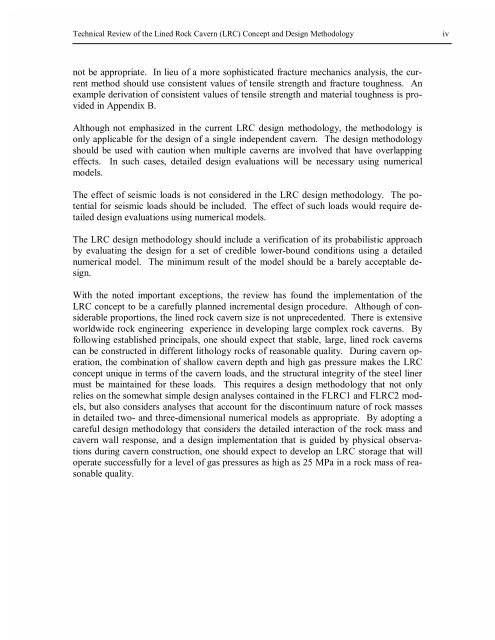Technical Review of the Lined Rock Cavern Concept and Design ...
Technical Review of the Lined Rock Cavern Concept and Design ...
Technical Review of the Lined Rock Cavern Concept and Design ...
You also want an ePaper? Increase the reach of your titles
YUMPU automatically turns print PDFs into web optimized ePapers that Google loves.
<strong>Technical</strong> <strong>Review</strong> <strong>of</strong> <strong>the</strong> <strong>Lined</strong> <strong>Rock</strong> <strong>Cavern</strong> (LRC) <strong>Concept</strong> <strong>and</strong> <strong>Design</strong> Methodology iv<br />
not be appropriate. In lieu <strong>of</strong> a more sophisticated fracture mechanics analysis, <strong>the</strong> current<br />
method should use consistent values <strong>of</strong> tensile strength <strong>and</strong> fracture toughness. An<br />
example derivation <strong>of</strong> consistent values <strong>of</strong> tensile strength <strong>and</strong> material toughness is provided<br />
in Appendix B.<br />
Although not emphasized in <strong>the</strong> current LRC design methodology, <strong>the</strong> methodology is<br />
only applicable for <strong>the</strong> design <strong>of</strong> a single independent cavern. The design methodology<br />
should be used with caution when multiple caverns are involved that have overlapping<br />
effects. In such cases, detailed design evaluations will be necessary using numerical<br />
models.<br />
The effect <strong>of</strong> seismic loads is not considered in <strong>the</strong> LRC design methodology. The potential<br />
for seismic loads should be included. The effect <strong>of</strong> such loads would require detailed<br />
design evaluations using numerical models.<br />
The LRC design methodology should include a verification <strong>of</strong> its probabilistic approach<br />
by evaluating <strong>the</strong> design for a set <strong>of</strong> credible lower-bound conditions using a detailed<br />
numerical model. The minimum result <strong>of</strong> <strong>the</strong> model should be a barely acceptable design.<br />
With <strong>the</strong> noted important exceptions, <strong>the</strong> review has found <strong>the</strong> implementation <strong>of</strong> <strong>the</strong><br />
LRC concept to be a carefully planned incremental design procedure. Although <strong>of</strong> considerable<br />
proportions, <strong>the</strong> lined rock cavern size is not unprecedented. There is extensive<br />
worldwide rock engineering experience in developing large complex rock caverns. By<br />
following established principals, one should expect that stable, large, lined rock caverns<br />
can be constructed in different lithology rocks <strong>of</strong> reasonable quality. During cavern operation,<br />
<strong>the</strong> combination <strong>of</strong> shallow cavern depth <strong>and</strong> high gas pressure makes <strong>the</strong> LRC<br />
concept unique in terms <strong>of</strong> <strong>the</strong> cavern loads, <strong>and</strong> <strong>the</strong> structural integrity <strong>of</strong> <strong>the</strong> steel liner<br />
must be maintained for <strong>the</strong>se loads. This requires a design methodology that not only<br />
relies on <strong>the</strong> somewhat simple design analyses contained in <strong>the</strong> FLRC1 <strong>and</strong> FLRC2 models,<br />
but also considers analyses that account for <strong>the</strong> discontinuum nature <strong>of</strong> rock masses<br />
in detailed two- <strong>and</strong> three-dimensional numerical models as appropriate. By adopting a<br />
careful design methodology that considers <strong>the</strong> detailed interaction <strong>of</strong> <strong>the</strong> rock mass <strong>and</strong><br />
cavern wall response, <strong>and</strong> a design implementation that is guided by physical observations<br />
during cavern construction, one should expect to develop an LRC storage that will<br />
operate successfully for a level <strong>of</strong> gas pressures as high as 25 MPa in a rock mass <strong>of</strong> reasonable<br />
quality.

















